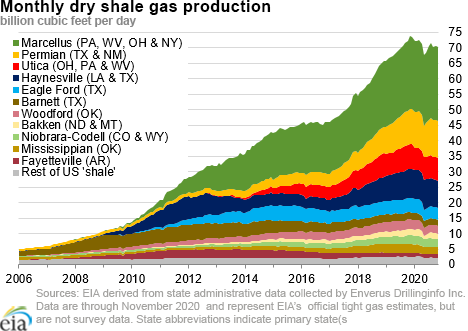In the News:
European consortium plans to transport hydrogen via repurposed natural gas pipelines
Norway’s Equinor, the largest producer of natural gas and crude oil in Europe, and Germany’s RWE, Europe’s second-largest electricity producer, joined the NortH2 green hydrogen consortium on December 7. Founded in February 2020 by a trio of Dutch companies—Gasunie, Groningen Seaports, and Shell Nederland—NortH2 aims to convert pipelines throughout the Netherlands and neighboring countries that carry natural gas with a low heat content (L-gas) into pipelines that transport green hydrogen produced from North Sea wind generation. Project development activities could begin in the second half of 2021, once a feasibility study is completed.
Currently, Gasunie, the Dutch natural gas transmission pipeline operator, maintains two parallel natural gas transmission systems in the Netherlands. One of the pipeline systems transports L-gas that has a high nitrogen component, and the second system transports natural gas with a higher heat-content (similar to what is delivered to U.S. natural gas consumers) that is primarily composed of methane. Because production of L-gas from the Groningen gas field, the Netherlands’ largest natural gas deposit, is being phased-out, the NortH2 project will extend the useable life of L-gas transmission pipelines.
Almost all global hydrogen is produced from fossil fuels, which contributes to carbon dioxide (CO2) emissions. The primary method of hydrogen production, both in the European Union (EU) and North America, is steam methane reforming (SMR). This process combines methane (natural gas) with steam at high temperatures to yield, through multiple steps, a pure hydrogen stream. With company-level and EU-wide net-zero CO2 goals in mind, NortH2 aims to produce green hydrogen through electrolysis of water using renewably-sourced electricity. Consortium partners propose to build 3 to 4 gigawatts (GW) of offshore wind generating capacity in the North Sea by 2030 and up to 10 GW by 2040 to power electrolyzers onshore at Eemshaven on the northern coast of the Netherlands. Because renewable electricity production is variable, depending on load factors, the consortium projects hydrogen production of approximately 1 million metric tons (mt) per year, the heat-content equivalent of about 300 million cubic feet per day (MMcf/d) of natural gas.
The hydrogen would be transported on repurposed L-gas pipelines to either an existing L-gas storage site at Zuidwending, or consumed by industrial consumers in the region. In line with goals outlined in the European Commission’s A hydrogen strategy for a climate-neutral Europe, released in July 2020, the green hydrogen would, in the initial phases, displace fossil-fuel derived hydrogen. Further down the line, it could contribute to the decarbonization of the petrochemical and iron & steel industries, which are not suitable for electrification.
Overview:
(For the week ending Wednesday, December 16, 2020)
- Natural gas spot prices rose at most locations this report week (Wednesday, December 9 to Wednesday, December 16). The Henry Hub spot price rose from $2.45 per million British thermal units (MMBtu) last Wednesday to $2.67/MMBtu yesterday.
- At the New York Mercantile Exchange (Nymex), the price of the January 2021 contract increased 24¢, from $2.442/MMBtu last Wednesday to $2.677/MMBtu yesterday. The price of the 12-month strip averaging January 2021 through December 2021 futures contracts climbed 20¢/MMBtu to $2.780/MMBtu.
- The net withdrawals from working gas totaled 122 billion cubic feet (Bcf) for the week ending December 11. Working natural gas stocks totaled 3,726 Bcf, which is 8% more than the year-ago level and 7% more than the five-year (2015–19) average for this week.
- The natural gas plant liquids composite price at Mont Belvieu, Texas, rose by 21¢/MMBtu, averaging $5.60/MMBtu for the week ending December 16. The prices of propane, isobutane, ethane, butane, and natural gasoline, all rose, by 1%, 1%, 4%, 8%, and 9%, respectively.
- According to Baker Hughes, for the week ending Tuesday, December 8, the natural gas rig count increased by 4 to 79. The number of oil-directed rigs rose by 12 to 258. The total rig count increased by 15, and it now stands at 338.
Prices/Supply/Demand:
Prices rise in most demand hubs. This report week (Wednesday, December 9 to Wednesday, December 16), the Henry Hub spot price rose 22¢ from $2.45/MMBtu last Wednesday to $2.67/MMBtu yesterday. Although temperatures across the country were generally cooler than normal, they were warmer than normal east of the Mississippi River. According to the American Community Survey, 56% of households that heat primarily with natural gas are in regions that experienced warmer–than-normal temperatures during the report week. At the Chicago Citygate, the price increased 28¢ from a low of $2.27/MMBtu last Wednesday to $2.55/MMBtu yesterday.
California prices rise. The price at PG&E Citygate in Northern California rose 24¢, up from $3.45/MMBtu last Wednesday to $3.69/MMBtu yesterday. The price at SoCal Citygate in Southern California increased 5¢ from $4.74/MMBtu last Wednesday to $4.79/MMBtu yesterday. Storage in the SoCalGas system ended yesterday at 76 Bcf, a surplus of 2.4 Bcf compared with the year-ago levels. The storage surplus has decreased over the past several months after increasing 19 Bcf higher than storage levels last December.
Northeast prices rise ahead of Nor’easter. A nor'easter storm brought heavy snow, strong winds, and coastal flooding to the Mid-Atlantic and Northeast yesterday and today. At the Algonquin Citygate, which serves Boston-area consumers, the price went up $6.74 from $2.70/MMBtu last Wednesday to a high of $9.44/MMBtu yesterday. At the Transcontinental Pipeline Zone 6 trading point for New York City, the price increased $3.18 from $2.35/MMBtu last Wednesday to a high of $5.53/MMBtu yesterday.
The Tennessee Zone 4 Marcellus spot price increased 10¢ from $1.85/MMBtu last Wednesday to $1.95/MMBtu yesterday. The price at Dominion South in southwest Pennsylvania rose 20¢ from $1.86/MMBtu last Wednesday to $2.06/MMBtu yesterday.
Permian Basin differential to the Henry Hub narrows. The price at the Waha Hub in West Texas, which is located near Permian Basin production activities, averaged $2.25/MMBtu last Wednesday, 20¢/MMBtu lower than the Henry Hub price. Yesterday, the price at the Waha Hub averaged $2.52/MMBtu, 15¢/MMBtu lower than the Henry Hub price.
Supply falls slightly. According to data from IHS Markit, the average total supply of natural gas fell by 0.1% compared with the previous report week. Dry natural gas production grew by 0.5% compared with the previous report week. Average net imports from Canada decreased by 8.4% from last week, but imports from Canada reached the highest daily level—6.5 Bcf/d on December 16, the day before the Nor’easter—since February 2020.
Demand rises, reaching a daily high for the heating season. Total U.S. consumption of natural gas rose by 0.4% compared with the previous report week, according to data from IHS Markit. On December 16, total demand reached a daily high of 124.8 Bcf/d, the highest level for this heating season. Natural gas consumption in the residential and commercial sectors increased by 3.9%, and power generation consumption declined by 4.4% week over week. Industrial sector consumption increased by 0.9% week over week. Natural gas exports to Mexico decreased 0.1%. Natural gas deliveries to U.S. liquefied natural gas (LNG) export facilities (LNG pipeline receipts) averaged 11.0 Bcf/d, which is 0.2 Bcf/d lower than last week. LNG pipeline receipts into Sempra Energy’s Cameron LNG were briefly disrupted on December 15 after a utility plant trip knocked the facility’s three liquefaction units (trains) offline, forcing Sempra to restart all three trains. Flows into Cameron LNG totaled about 1.2 Bcf/d on December 15 compared with more than 2.1 Bcf/d in the days before the disruption.
U.S. LNG exports are flat week over week. Twenty two LNG vessels (seven from Sabine Pass, five from Freeport, four each from Corpus Christi and Cameron, and two from Cove Point) with a combined LNG-carrying capacity of 78 Bcf departed the United States between December 10 and December 16, 2020, according to shipping data provided by Bloomberg Finance, L.P.
Storage:
The net withdrawals from storage totaled 122 Bcf for the week ending December 11, compared with the five-year (2015–19) average net withdrawals of 105 Bcf and last year's net withdrawals of 97 Bcf during the same week. Working natural gas stocks totaled 3,726 Bcf, which is 243 Bcf more than the five-year average and 284 Bcf more than last year at this time.
According to The Desk survey of natural gas analysts, estimates of the weekly net change to working natural gas stocks ranged from net withdrawals of 105 Bcf to 138 Bcf, with a median estimate of 121 Bcf.
More storage data and analysis can be found on the Natural Gas Storage Dashboard and the Weekly Natural Gas Storage Report.
See also:
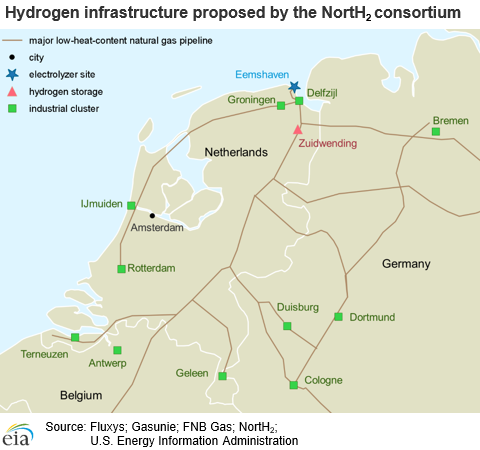
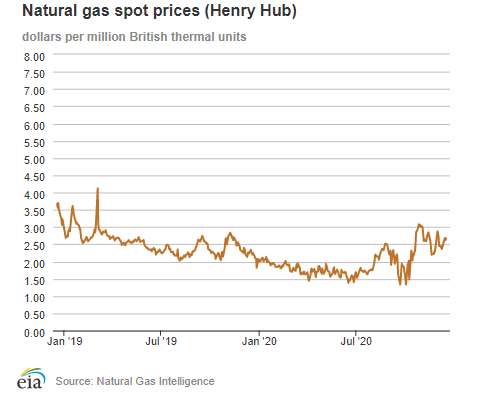
| Spot Prices ($/MMBtu) | Thu, 10-Dec |
Fri, 11-Dec |
Mon, 14-Dec |
Tue, 15-Dec |
Wed, 16-Dec |
|---|---|---|---|---|---|
| Henry Hub |
2.44 |
2.55 |
2.68 |
2.63 |
2.67 |
| New York |
1.99 |
2.14 |
2.82 |
4.22 |
5.53 |
| Chicago |
2.27 |
2.42 |
2.60 |
2.56 |
2.55 |
| Cal. Comp. Avg.* |
3.28 |
3.37 |
3.76 |
3.78 |
3.72 |
| Futures ($/MMBtu) | |||||
| January contract | 2.553 |
2.591 |
2.682 |
2.682 |
2.677 |
| February contract |
2.570 |
2.603 |
2.678 |
2.680 |
2.681 |
| *Avg. of NGI's reported prices for: Malin, PG&E Citygate, and Southern California Border Avg. | |||||
| Source: NGI's Daily Gas Price Index | |||||
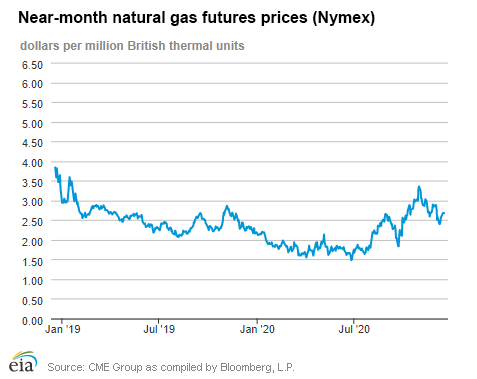
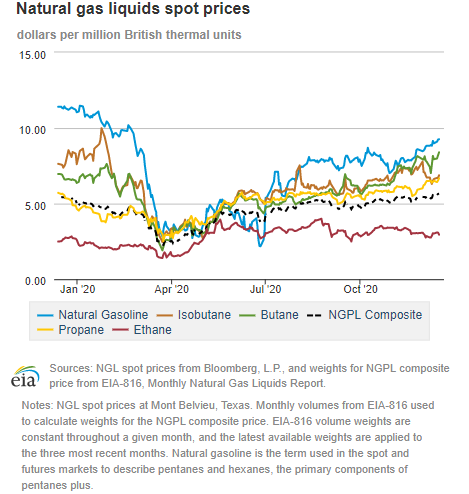
| U.S. natural gas supply - Gas Week: (12/10/20 - 12/16/20) | |||
|---|---|---|---|
Average daily values (Bcf/d): |
|||
this week |
last week |
last year |
|
| Marketed production | 101.8 |
101.1 |
106.7 |
| Dry production | 90.4 |
89.9 |
95.8 |
| Net Canada imports | 5.2 |
5.7 |
4.6 |
| LNG pipeline deliveries | 0.1 |
0.2 |
0.2 |
| Total supply | 95.7 |
95.8 |
100.5 |
|
Source: IHS Markit | |||
| U.S. natural gas consumption - Gas Week: (12/10/20 - 12/16/20) | |||
|---|---|---|---|
Average daily values (Bcf/d): |
|||
this week |
last week |
last year |
|
| U.S. consumption | 88.2 |
87.9 |
96.3 |
| Power | 27.1 |
28.4 |
30.4 |
| Industrial | 24.5 |
24.3 |
24.6 |
| Residential/commercial | 36.5 |
35.2 |
41.3 |
| Mexico exports | 5.6 |
5.6 |
5.2 |
| Pipeline fuel use/losses | 7.5 |
7.4 |
8.0 |
| LNG pipeline receipts | 11.0 |
11.2 |
7.9 |
| Total demand | 112.2 |
112.0 |
117.5 |
|
Source: IHS Markit | |||
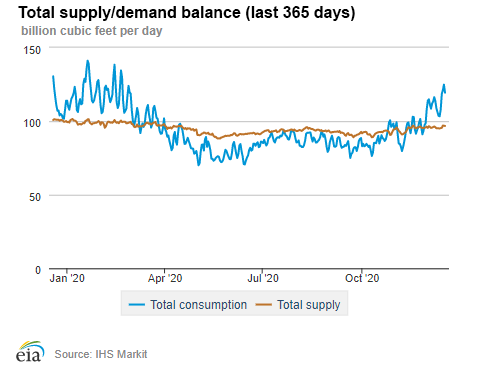
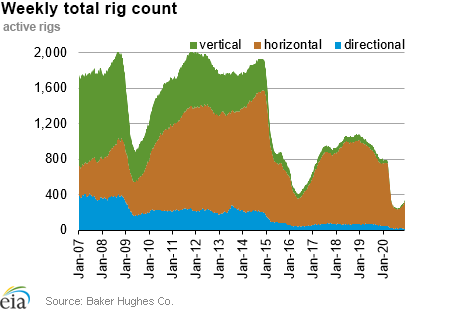
| Rigs | |||
|---|---|---|---|
Tue, December 08, 2020 |
Change from |
||
last week |
last year |
||
| Oil rigs | 258 |
4.9% |
-61.3% |
| Natural gas rigs | 79 |
5.3% |
-38.8% |
| Note: Excludes any miscellaneous rigs | |||
| Rig numbers by type | |||
|---|---|---|---|
Tue, December 08, 2020 |
Change from |
||
last week |
last year |
||
| Vertical | 15 |
-6.3% |
-72.2% |
| Horizontal | 306 |
5.9% |
-55.8% |
| Directional | 17 |
-5.6% |
-67.3% |
| Source: Baker Hughes Co. | |||
| Working gas in underground storage | ||||
|---|---|---|---|---|
Stocks billion cubic feet (Bcf) |
||||
| Region | 2020-12-11 |
2020-12-04 |
change |
|
| East | 881 |
915 |
-34 |
|
| Midwest | 1,059 |
1,095 |
-36 |
|
| Mountain | 223 |
232 |
-9 |
|
| Pacific | 306 |
312 |
-6 |
|
| South Central | 1,256 |
1,294 |
-38 |
|
| Total | 3,726 |
3,848 |
-122 |
|
|
Source: Form EIA-912, Weekly Underground Natural Gas Storage Report | ||||
| Working gas in underground storage | |||||
|---|---|---|---|---|---|
Historical comparisons |
|||||
Year ago (12/11/19) |
5-year average (2015-2019) |
||||
| Region | Stocks (Bcf) |
% change |
Stocks (Bcf) |
% change |
|
| East | 846 |
4.1 |
827 |
6.5 |
|
| Midwest | 984 |
7.6 |
995 |
6.4 |
|
| Mountain | 188 |
18.6 |
199 |
12.1 |
|
| Pacific | 274 |
11.7 |
295 |
3.7 |
|
| South Central | 1,149 |
9.3 |
1,167 |
7.6 |
|
| Total | 3,442 |
8.3 |
3,483 |
7.0 |
|
| Source: Form EIA-912, Weekly Underground Natural Gas Storage Report | |||||
| Temperature – heating & cooling degree days (week ending Dec 10) | ||||||||
|---|---|---|---|---|---|---|---|---|
HDD deviation from: |
CDD deviation from: |
|||||||
| Region | HDD Current |
normal |
last year |
CDD Current |
normal |
last year |
||
| New England | 212 |
-4 |
-8 |
0 |
0 |
0 |
||
| Middle Atlantic | 202 |
-3 |
0 |
0 |
0 |
0 |
||
| E N Central | 208 |
-28 |
-15 |
0 |
0 |
0 |
||
| W N Central | 191 |
-71 |
-60 |
0 |
0 |
0 |
||
| South Atlantic | 153 |
9 |
26 |
4 |
-5 |
-6 |
||
| E S Central | 154 |
6 |
32 |
0 |
-1 |
0 |
||
| W S Central | 99 |
-10 |
22 |
0 |
-3 |
-5 |
||
| Mountain | 186 |
-31 |
4 |
0 |
0 |
0 |
||
| Pacific | 86 |
-28 |
-10 |
0 |
-1 |
0 |
||
| United States | 164 |
-20 |
-4 |
1 |
-1 |
-2 |
||
|
Note: HDD = heating degree day; CDD = cooling degree day Source: National Oceanic and Atmospheric Administration | ||||||||
Average temperature (°F)
7-day mean ending Dec 10, 2020
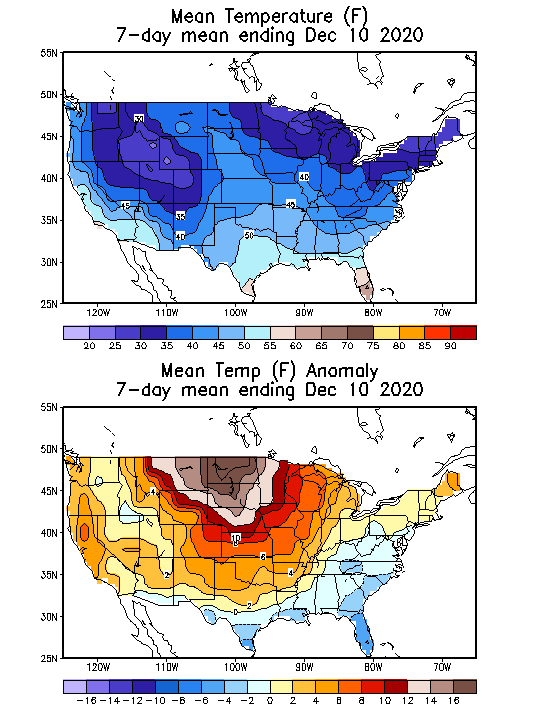
Source: National Oceanic and Atmospheric Administration
Deviation between average and normal (°F)
7-day mean ending Dec 10, 2020

Source: National Oceanic and Atmospheric Administration

